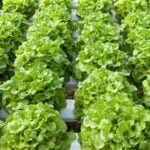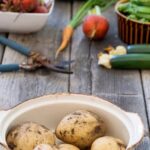As the summer days start to wane and the cool, crisp air of fall begins to settle in, it’s time to turn our attention to fall vegetable gardening. Whether you’re a seasoned gardener or a beginner with a green thumb, there are plenty of options for growing delicious and nutritious vegetables during the autumn months.
From choosing the right vegetables to dealing with pests and diseases, this comprehensive guide will walk you through everything you need to know about fall vegetable gardening.
When it comes to fall vegetable gardening, there are a wide variety of options to choose from. The cooler temperatures of fall create the perfect environment for certain vegetables to thrive, making it an ideal time to explore new crops and experiment with different varieties. In this article, we’ll discuss how to select the best vegetables for fall planting based on your climate and growing conditions.
In addition to choosing the right vegetables, preparing your garden for fall planting is crucial for success. We’ll cover essential tips for getting your garden beds ready for autumn planting, including soil preparation, mulching, and irrigation. By following these guidelines, you can ensure that your fall vegetable garden gets off to a strong start and continues to produce bountiful harvests throughout the season.
Choosing the Right Vegetables for Fall Planting
When it comes to fall vegetable gardening, choosing the right vegetables for planting is crucial to a successful harvest. Not all vegetables thrive in the cooler temperatures of the fall season, so it’s important to select varieties that are well-suited for this time of year. Some vegetables actually prefer the cooler weather and can even taste better when grown in the fall.
One popular choice for fall vegetable gardening is leafy greens such as spinach, kale, and lettuce. These vegetables are not only able to tolerate colder temperatures, but they also tend to thrive in them. Root vegetables like carrots, beets, and radishes are also great options for fall planting. They can withstand light frosts and continue to grow until the ground freezes.
Other suitable choices for fall vegetable gardening include broccoli, cauliflower, Brussels sprouts, and cabbage. These cold-hardy vegetables can be planted in late summer or early fall and will mature during the cooler months. Additionally, garlic is a staple for fall planting as it requires a period of cold weather in order to produce bulbs.
Preparing Your Garden for Fall Planting
When preparing your garden for fall planting, there are a few important considerations to keep in mind to ensure a successful harvest. One of the first steps is to clear out any remaining summer vegetables and weeds from your garden beds.
This will help prevent any pests or diseases from carrying over into the fall season. Additionally, it’s a good idea to add compost or other organic matter to enrich the soil and provide essential nutrients for your fall crops.
Once your garden beds are clear and amended with fresh soil, it’s time to consider the best layout for planting your fall vegetables. Be sure to take into account the space requirements of each plant as well as their sunlight needs. For example, taller plants such as corn or trellised beans should be positioned so they won’t shade smaller crops like lettuce or spinach.
Another key aspect of preparing your garden for fall planting is ensuring proper irrigation. As the weather begins to cool down, it’s easy to forget that plants will still need water, especially during dry spells. Setting up a reliable watering system, whether it’s drip irrigation or soaker hoses, will help ensure that your fall crops receive consistent moisture.
By taking these preparatory steps, you can set the stage for a bountiful fall vegetable garden. With careful planning and attention to detail, you can maximize your harvest and enjoy an abundance of fresh produce well into the cooler months ahead.
Tips for Extending the Fall Growing Season
Fall Vegetable gardening can be incredibly rewarding, but it’s important to make the most of the fall growing season. Extending the growing season allows for an abundance of fresh vegetables and herbs well into the autumn months. There are several tips and techniques to help you achieve this.
Cover Your Crops
One effective method for extending the fall growing season is by covering your crops. Row covers, cloches, cold frames, and hoop houses can protect plants from frost and keep them warm as temperatures start to drop. This extra warmth can give your vegetables a few extra weeks or even months of growth.
Use Mulch
Another way to extend the fall growing season is by using mulch. Mulch helps to insulate the soil and maintain warmth, protecting plants from temperature fluctuations. In addition to this, mulch also helps retain moisture, which is crucial during dry fall weather. Organic materials such as straw, leaves, or grass clippings can work great as mulch for your fall vegetable garden.
Grow Quick-Maturing Varieties
Choosing quick-maturing vegetable varieties is another strategy for extending the fall growing season. By selecting varieties with shorter maturity dates, you can maximize your chances of harvesting before colder temperatures set in. Examples of these quick-maturing crops include radishes, lettuce, spinach, and arugula. It’s also a good idea to sow seeds directly into warmed soil to speed up germination and growth.
By implementing these techniques for extending the fall growing season, you can enjoy a bountiful harvest well beyond summer and into late autumn with success in your fall vegetable gardening endeavors.
Dealing With Common Fall Garden Pests and Diseases
As you gear up for fall vegetable gardening, it’s important to be prepared to deal with common pests and diseases that may plague your garden. Here are some tips to help you keep your fall vegetables healthy and thriving:
- Monitor Your Garden: Regularly inspect your plants for any signs of pest infestations or disease. Catching problems early can prevent them from spreading and causing extensive damage.
- Natural Pest Control Methods: Consider using natural pest control methods such as introducing beneficial insects like ladybugs or parasitic wasps to help keep pest populations in check.
- Companion Planting: Utilize companion planting techniques by growing plants that repel pests or attract beneficial insects. For example, planting marigolds near your vegetables can help deter nematodes.
In addition to pests, fall vegetable gardens can also be susceptible to certain diseases. Here are some tips for preventing and managing common fall garden diseases:
- Proper Plant Spacing: Ensure that your plants have adequate spacing to promote good air circulation, which can help prevent the spread of fungal diseases such as powdery mildew.
- Watering Practices: Avoid overhead watering, which can contribute to the development of fungal diseases. Instead, water at the base of the plants early in the day so that foliage has time to dry before evening.
- Crop Rotation: Practice crop rotation by avoiding planting members of the same plant family in the same location year after year. This can help reduce the buildup of soil-borne diseases.
By being proactive and implementing these strategies, you can minimize the impact of pests and diseases on your fall vegetable garden, allowing you to enjoy a bountiful harvest.
Harvesting and Preserving Fall Vegetables
Fall is a wonderful time to harvest a variety of vegetables from your garden. Whether you’re growing hearty greens, root vegetables, or cruciferous vegetables, there are many ways to ensure that your harvest lasts well into the colder months. Here are some tips for harvesting and preserving fall vegetables to enjoy the fruits of your labor long after the growing season has ended.
Harvesting Fall Vegetables
When it comes to harvesting fall vegetables, timing is everything. Some vegetables, like kale and spinach, can be continually harvested throughout the fall season as they mature. Other vegetables, such as carrots and winter squash, should be left in the ground until just before the first hard frost. Be sure to research the best harvesting times for each vegetable in your garden to ensure that you pick them at their peak flavor and freshness.
Preserving Fall Vegetables
Preserving fall vegetables is an excellent way to enjoy your harvest well into the winter months. Canning, freezing, and pickling are all great methods of preserving fall vegetables for later use. Consider making homemade tomato sauce from your end-of-season tomatoes or pickling some of your surplus cucumbers. Freezing veggies like peas or corn can also help you enjoy the flavors of summer long after they’ve gone.
Drying Fall Vegetables
Another option for preserving your fall vegetable harvest is drying. Many herbs can be dried easily and used in cooking throughout the year. In addition, some vegetables like hot peppers or cherry tomatoes can be dried as well for use in various dishes. Investing in a food dehydrator can make the drying process simple and efficient.
By taking the time to properly harvest and preserve your fall vegetable bounty, you’ll be able to enjoy fresh produce from your garden even when winter has arrived. Plus, it’s incredibly satisfying to know that you’re enjoying fruits (or rather, veggies) of your labor well beyond the traditional growing season.
Success Stories
Fall vegetable gardening can be a rewarding and fruitful experience for gardeners of all skill levels. Many people have found success in growing their own vegetables during the fall season, and their stories can serve as inspiration for those looking to try their hand at fall gardening.
Here are some success stories from fellow gardeners who have had great experiences with fall vegetable gardening:
- Sarah, a beginner gardener, decided to try her hand at fall vegetable gardening after reading about the benefits of growing cold-hardy crops. She planted a variety of vegetables including kale, carrots, and beets in her garden beds in early September.
Despite her initial concerns about the cooler temperatures, she was pleasantly surprised to see her vegetables thrive throughout the fall season. By late October, she was able to enjoy a bountiful harvest of fresh and nutritious produce right from her own backyard. - Mark, an experienced gardener, has been practicing fall vegetable gardening for many years and has honed his skills in extending the growing season. He shared that using row covers and cold frames has allowed him to protect his plants from early frosts and continue harvesting well into November. By utilizing these techniques, he has been able to enjoy an abundant supply of fresh greens and root vegetables long after summer has ended.
- Jessica, a community gardener, found success in collaborating with fellow gardeners to create a communal fall vegetable garden. Together, they planned their crops carefully and shared resources such as compost and tools. By pooling their knowledge and efforts, they were able to create a thriving garden that provided them with an abundance of fresh produce throughout the fall months.
These success stories demonstrate that with proper planning and care, fall vegetable gardening can yield satisfying results for both beginners and experienced gardeners alike. Whether it’s overcoming challenges or trying innovative techniques, these stories show how anyone can find success with fall vegetable gardening.
Fall Vegetable Gardening Checklist
In conclusion, fall vegetable gardening can be a rewarding and productive endeavor for those looking to extend their gardening season. By choosing the right vegetables for fall planting, adequately preparing the garden, and following tips to extend the growing season, beginners can experience success with fall vegetable gardening. Despite potential challenges such as pests and diseases, with proper care and attention, a bountiful harvest of fall vegetables can be achieved.
It is important for beginners to remember that successful fall vegetable gardening requires careful planning and execution. By following a step-by-step guide, such as the Fall Vegetable Gardening Checklist provided in this article, beginners can navigate the process with ease and confidence. Additionally, learning from success stories of others who have found success with fall vegetable gardening can offer valuable insight and inspiration for newcomers to the practice.
As fall approaches, now is the perfect time for beginners to start planning their fall vegetable garden. With the right preparation and guidance, those new to fall vegetable gardening can enjoy the satisfaction of harvesting and preserving their own homegrown produce. So why not take advantage of this opportunity to try fall vegetable gardening? It’s an exciting journey that may lead to a delicious harvest of fresh, nutritious vegetables.
Frequently Asked Questions
What Vegetables Are Good to Grow in the Fall?
Vegetables that are good to grow in the fall include leafy greens like kale, spinach, and lettuce, as well as root vegetables such as carrots, beets, and radishes. Other options are broccoli, cauliflower, and Brussels sprouts.
When Should I Plant My Fall Vegetable Garden?
The timing for planting a fall vegetable garden depends on your specific location and climate. In general, it’s recommended to start planting fall vegetables in late summer or early fall to allow them enough time to mature before the first frost.
Is It Too Late to Plant Fall Vegetables September?
It’s not too late to plant fall vegetables in September, especially if you choose quick-maturing varieties. While some crops may need to be started earlier in the season from seed indoors or transplanted as seedlings, there are still many vegetables that can be directly sown into the garden soil in September for a fall harvest.

If you’re looking to get into vegetable gardening, or are just looking for some tips on how to make your current garden better, then you’ve come to the right place! My name is Ethel and I have been gardening for years. In this blog, I’m going to share with you some of my best tips on how to create a successful vegetable garden.





